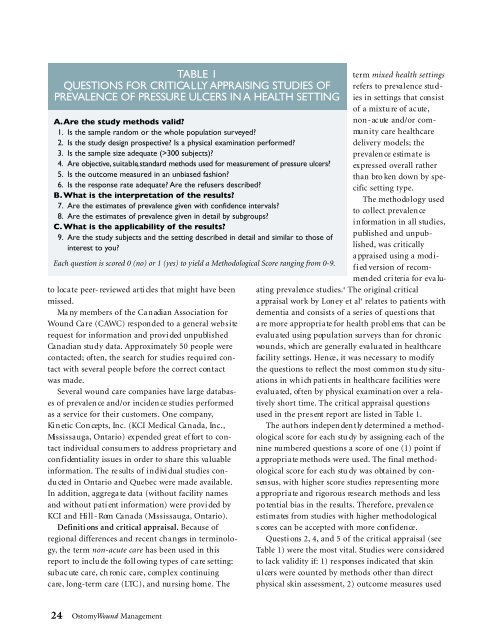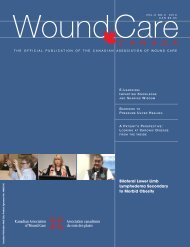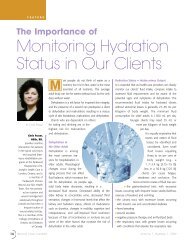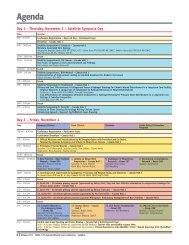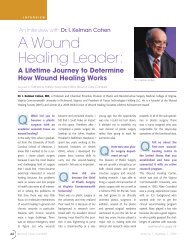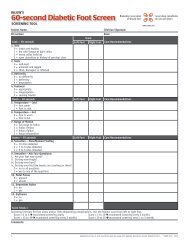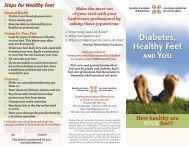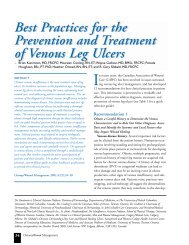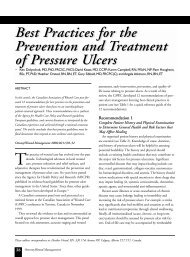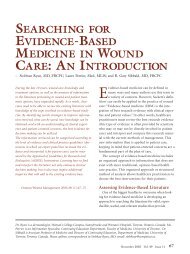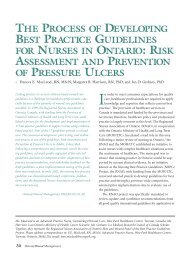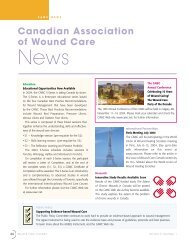M. Gail Woodbury, BScPT, MSc, PhD - Canadian Association of ...
M. Gail Woodbury, BScPT, MSc, PhD - Canadian Association of ...
M. Gail Woodbury, BScPT, MSc, PhD - Canadian Association of ...
You also want an ePaper? Increase the reach of your titles
YUMPU automatically turns print PDFs into web optimized ePapers that Google loves.
TABLE 1<br />
QUESTIONS FOR CRITICA L LY APPRAISING STUDIES OF<br />
P R E VALENCE OF PRESSURE ULCERS IN A HEALTH SETTING<br />
A.Are the study methods valid?<br />
1. Is the sample random or the whole population surveyed?<br />
2. Is the study design prospective? Is a physical examination performed?<br />
3. Is the sample size adequate (>300 subjects)?<br />
4 . A re objective, s u i t a b l e,s t a n d a rd methods used for measurement <strong>of</strong> pre s s u re ulcers?<br />
5. Is the outcome measured in an unbiased fashion?<br />
6. Is the response rate adequate? Are the refusers described?<br />
B. What is the interpretation <strong>of</strong> the results?<br />
7. Are the estimates <strong>of</strong> prevalence given with confidence intervals?<br />
8. Are the estimates <strong>of</strong> prevalence given in detail by subgroups?<br />
C. What is the applicability <strong>of</strong> the results?<br />
9. Are the study subjects and the setting described in detail and similar to those <strong>of</strong><br />
interest to you?<br />
Each question is scored 0 (no) or 1 (yes) to yield a Methodological Score ranging from 0-9.<br />
to loc a te peer- revi ewed arti cles that might have been<br />
m i s s ed .<br />
Ma ny mem bers <strong>of</strong> the Ca n adian As s oc i a ti on for<br />
Wound Ca re (CAWC) re s pon ded to a gen eral web s i te<br />
request for inform a ti on and provi ded unpubl i s h ed<br />
Ca n adian stu dy data. Approx i m a tely 50 people were<br />
con t acted ; <strong>of</strong> ten , the search for studies requ i red cont<br />
act with several people before the correct con t act<br />
was made .<br />
Several wound care companies have large databases<br />
<strong>of</strong> preva l en ce and/or inciden ce studies perform ed<br />
as a servi ce for their custom ers . One com p a ny,<br />
Ki n etic Con cept s , In c . ( KCI Medical Ca n ad a , In c . ,<br />
Mi s s i s s a u ga , O n t a rio) ex pen ded great ef fort to cont<br />
act indivi dual con su m ers to ad d ress propri et a ry and<br />
con f i den ti a l i ty issues in order to share this va lu a bl e<br />
i n form a ti on . The re sults <strong>of</strong> i n d ivi dual studies condu<br />
cted in Ontario and Quebec were made ava i l a bl e .<br />
In ad d i ti on , a ggrega te data (wi t h o ut fac i l i ty names<br />
and wi t h o ut pati ent inform a ti on) were provi ded by<br />
KCI and Hi ll - Rom Ca n ada (Mi s s i s s a u ga , O n t a ri o ) .<br />
D ef i n i ti ons and cri tical app ra i s a l . Because <strong>of</strong><br />
regi onal differen ces and recent ch a n ges in term i n o l ogy,<br />
the term n o n - a c u te care has been used in this<br />
report to inclu de the fo ll owing types <strong>of</strong> c a re set ti n g :<br />
su b ac ute care , ch ronic care , com p l ex con ti nu i n g<br />
c a re , l on g - term care (LTC ) , and nu rsing hom e . Th e<br />
24 OstomyWound Management<br />
term m i x ed health set ti n gs<br />
refers to preva l en ce stu dies<br />
in set ti n gs that con s i s t<br />
<strong>of</strong> a mixtu re <strong>of</strong> ac ute ,<br />
n on - ac ute and/or commu<br />
n i ty care healthcare<br />
del ivery model s ; t h e<br />
preva l en ce esti m a te is<br />
ex pre s s ed overa ll ra t h er<br />
than bro ken down by specific<br />
set ting type .<br />
The met h odo l ogy used<br />
to co ll ect preva l en ce<br />
i n form a ti on in all stu d i e s ,<br />
p u bl i s h ed and unpubl<br />
i s h ed , was cri ti c a lly<br />
a ppra i s ed using a mod if<br />
i ed vers i on <strong>of</strong> recomm<br />
en ded cri teria for eva lua<br />
ting preva l en ce stu d i e s . 4 The ori ginal cri ti c a l<br />
a ppraisal work by Lon ey et al 4 rel a tes to pati ents wi t h<br />
dem en tia and consists <strong>of</strong> a series <strong>of</strong> qu e s ti ons that<br />
a re more appropri a te for health probl ems that can be<br />
eva lu a ted using pop u l a ti on su rveys than for ch ron i c<br />
wo u n d s , wh i ch are gen era lly eva lu a ted in healthcare<br />
f ac i l i ty set ti n gs . Hen ce , it was nece s s a ry to mod i f y<br />
the qu e s ti ons to ref l ect the most com m on stu dy situa<br />
ti ons in wh i ch pati ents in healthcare fac i l i ties were<br />
eva lu a ted , <strong>of</strong> ten by physical ex a m i n a ti on over a rel atively<br />
short ti m e . The cri tical appraisal qu e s ti on s<br />
u s ed in the pre s ent report are listed in Ta ble 1.<br />
The aut h ors indepen den t ly determ i n ed a met h odo<br />
l ogical score for each stu dy by assigning each <strong>of</strong> t h e<br />
nine nu m bered qu e s ti ons a score <strong>of</strong> one (1) point if<br />
a ppropri a te met h ods were used . The final met h odo<br />
l ogical score for each stu dy was obt a i n ed by cons<br />
en su s , with high er score studies repre s en ting more<br />
a ppropri a te and ri gorous re s e a rch met h ods and less<br />
po ten tial bias in the re su l t s . Th erefore , preva l en ce<br />
e s ti m a tes from studies with high er met h odo l ogi c a l<br />
s cores can be accepted with more con f i den ce .<br />
Q u e s ti ons 2, 4 , and 5 <strong>of</strong> the cri tical appraisal (see<br />
Ta ble 1) were the most vi t a l . S tudies were con s i dered<br />
to lack va l i d i ty if: 1) re s ponses indicated that skin<br />
u l cers were co u n ted by met h ods other than direct<br />
physical skin assessmen t , 2) outcome measu res used


